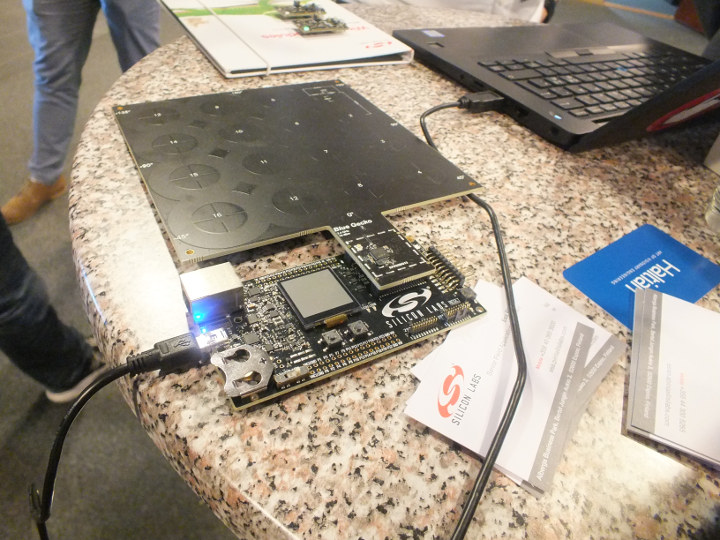Recently there are been advancements related to precise indoor positioning with the announcement for Bluetooth 5.1 and 802.15.4z. Both can provide 1 to 10 centimeters accuracy with minimal lag, and Bluetooth 5.1 achieves this through Angle of Arrival (AoA) and Angle of Departure (AoD) features and an antenna array.
I had never seen the new feature in action, but Silicon Labs recently demonstrated Bluetooth 5.1 location technology at Arrow IoT summit with a DMX-512 connected light following a person carrying a Bluetooth 5.1 tag.
It looks fairly accurate, and it does not have a 3-6 seconds lag like previous solutions based on earlier versions of Bluetooth?
So what does one need to enable Bluetooth 5.1 location finding?

First, we’ll need a Bluetooth 5.1 base station with an antenna array, The one used above includes a 16 antenna array (4×4 grid) used to calculated angles of departure and arrival and ultimately the position and direction of the beacons. The Silabs Blue Gecko MCU powered base station can be connected to a computer over USB or Ethernet for visualization, or in this instance to control the light.
You’ll also need a coin-cell powered Bluetooth 5.1 beacon that sends the signals allowing tracking. Apparently, this can also work in reverse, where several beacons are stationary, and the base station(s) is/are moving around for example for heavy machinery tracking.
Tracking has its uses, but if you are uneasy with Bluetooth LE tracking, BLE and MAC randomization are techniques used to make devices harder to track. This is apparently enabled by default on iOS and MacOS, except for Apple TV.
If you’d like to know more about Bluetooth 5.1 location & direction finding, read more on Silicon Labs website.

Jean-Luc started CNX Software in 2010 as a part-time endeavor, before quitting his job as a software engineering manager, and starting to write daily news, and reviews full time later in 2011.
Support CNX Software! Donate via cryptocurrencies, become a Patron on Patreon, or purchase goods on Amazon or Aliexpress






So this is not something we can expect to see a key finding app for anytime soon then…
The main market for this is tracking the flow of people in stores and events.
But… over time this may become feasible for home use by using the antenna arrays already built into 802.11n routers. Or someone might come up with a clever way of etching the array into a small PCB. That looks like a PCB antenna in the photo but it is a foot square. The electronics are not so complex since the smarts are built into the SiLab Bluetooth chips, those chips have GPIOs which are used to switch between the antennas. You then need to add an antenna switching chip (that chip on the antenna board in the photo) and the antenna array. PCB antennas are cheap, the trick is in making them small enough to be acceptable to consumer devices. Do note that that you don’t have to use a planar array or 16 antennas. Something like a six side cube should also be effective. But… the further you can spatially separate the antenna elements, the more accurate it will be.
You need three of these devices to do fixed triangulation. If the antenna array is moving, you need three fixed beacons.
The MAC randomization won’t do anything to stop location tracking, location tracking works by detecting the phase difference in the radio signals. So to stop location tracking, just turn off your BLE.
What MAC randomization does is stop them from identifying you on repeated visits. Each time you come back to the store you will have a different MAC address so they can’t associate your repeated visits.
TOF (time of flight) is another scheme that is simpler. But TOF requires active participation from the end user device and the end user device may not want to cooperate. It also sucks more power. The phased array antennas can passively track BLE.
Why even bother to make antennas small? There are plenty of wall-hanging consumer devices, that are supposed to be big enough to accommodate antenna of this size. Wall clock or picture frames being the first examples to come to mind.
”Why even make computers small. Nobody will ever need a computer smaller than the size of a science laboratory!!”
Isn’t BT5.1 a coherent system? If yes then why aren’t they employing ToF to enhance accuracy, resolution and/or range through range multilateration in addition to the existing triangulation via AoA/D? It should not require additional hardware.
How does one go about purchasing a devkit as shown? ie. base station + antenna + beacon